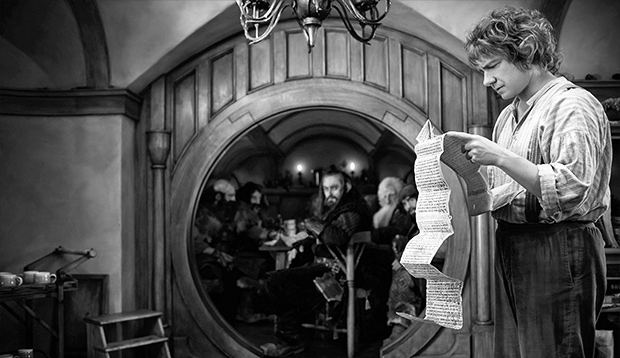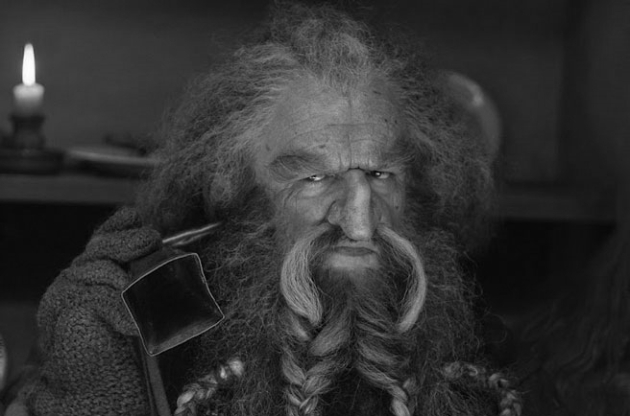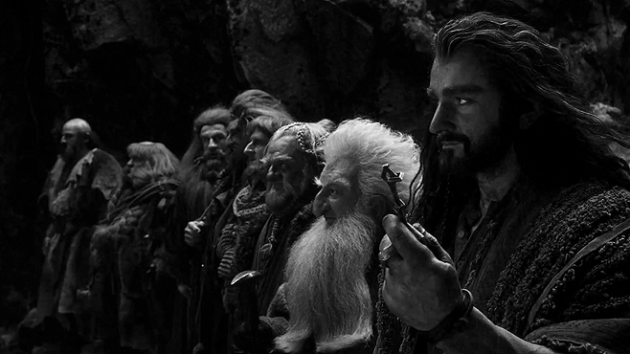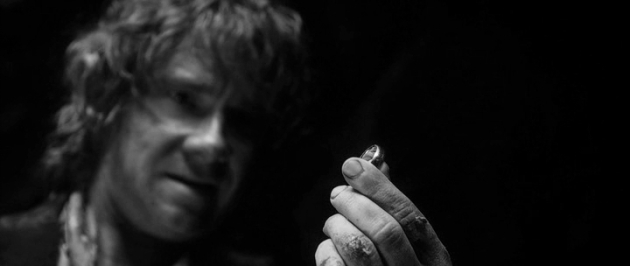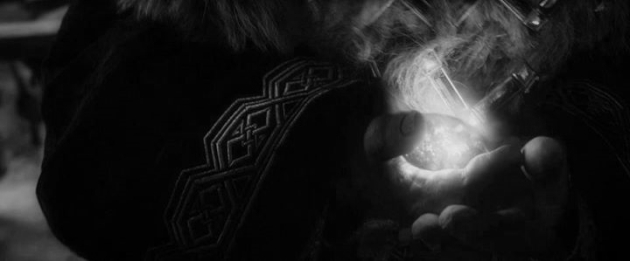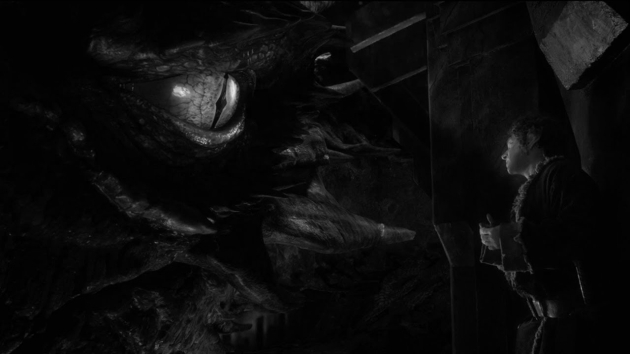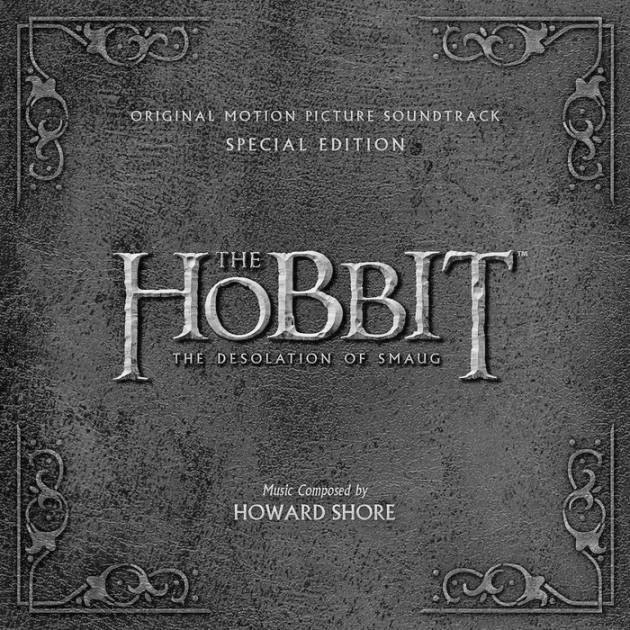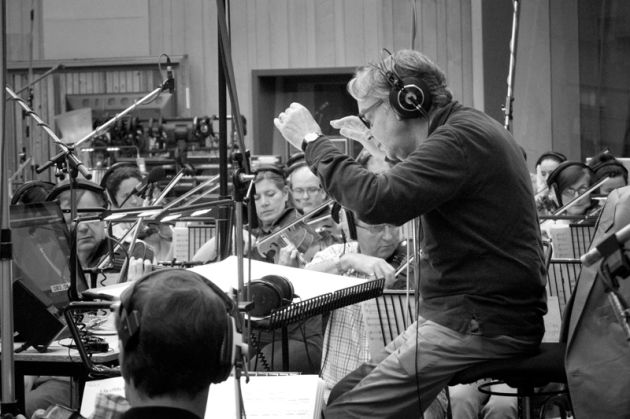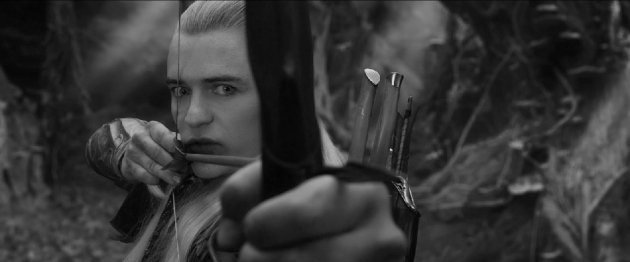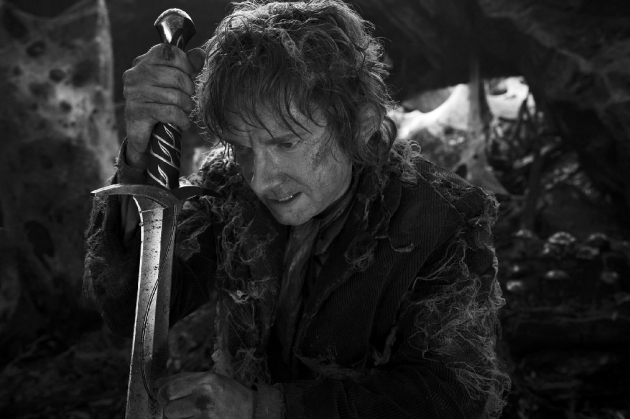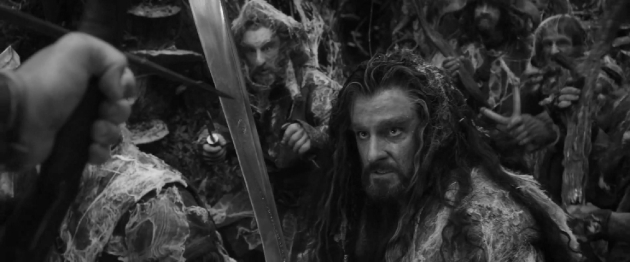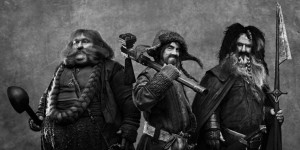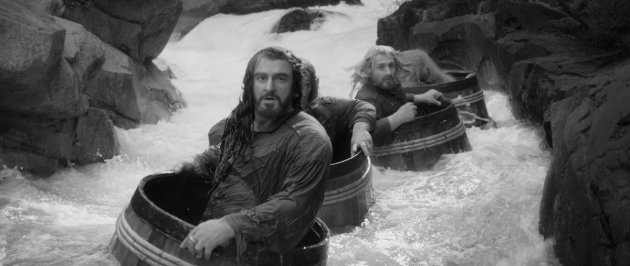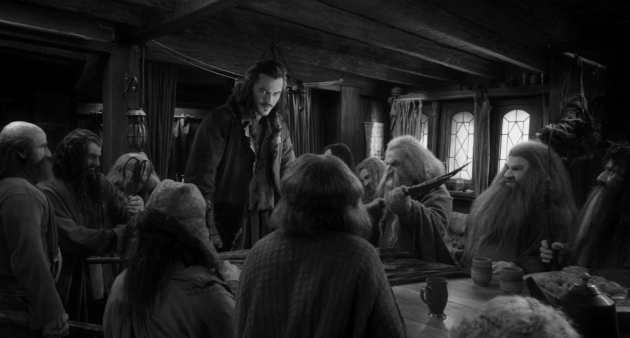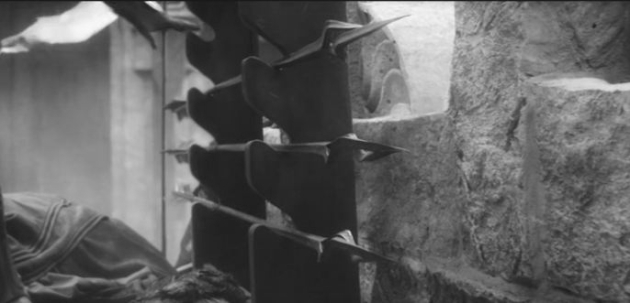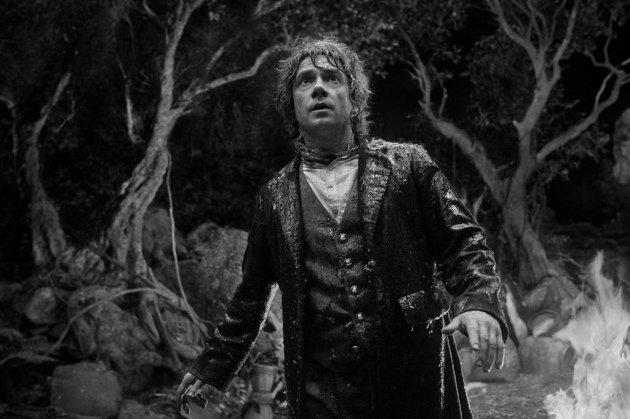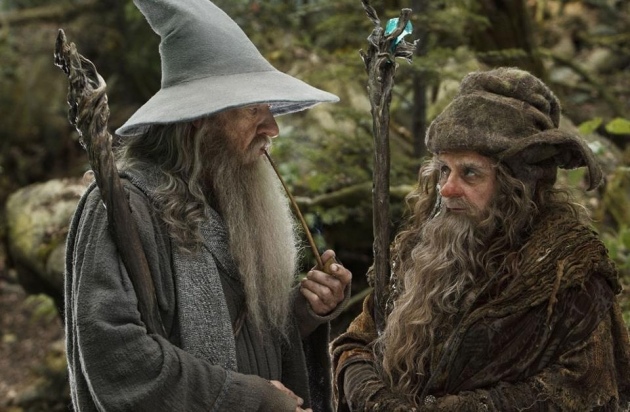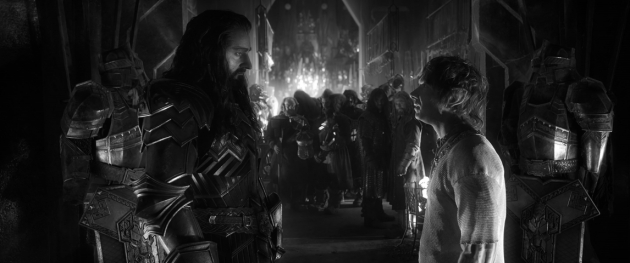
If you’re reading this, you’re probably aware that I have devoted extensive time to writing about the Hobbit trilogy. By now everyone knows that this series was never intended to be a straightforward retelling of the book but rather a modern fantasy epic using the style and appendices of The Lord of the Rings. While the accusations of narrative bloat and creative shortcomings have accompanied many reviews of the new trilogy, it’s easy to forget that the glory of Lord of the Rings is not without its own complications.
When I saw The Fellowship of the Ring I was a high school freshman several months after September 11 rocked the nation. It was the most exciting, imaginative, and beautiful movie I had ever seen. I went back and saw it in the theater two more times. But many of the college students I talk to today have never seen Lord of the Rings nor are interested in doing so. The Return of the King‘s famous Oscar sweep in 2004 might as well be ancient history to them. The first trilogy despite it many merits still struggles to have an appeal outside of genre fans.
And long before the complaints about Radagast and Tauriel began rolling in, Tolkien purists remained rather vigilant about the numerous changes from the books. Aragorn wasn’t supposed to be self-doubting. Tom Bombadil wasn’t an expendable side character. Gimli was never supposed to play for comic relief. Despite spawning a widespread fanbase and garnering academy approval, Peter Jackson’s first trilogy had its own share of concerns. For many adult filmgoers, this whole project was simply too long, too slow, and too incomprehensible.
Holding up Lord of the Rings as the golden standard and The Hobbit films as its less inspired relative obscures several facts. The young people who most needed fantasy in 2001 are all grown up and the new generation most likely to relate to this genre have found a replacement in Harry Potter, Twilight, The Hunger Games. It is also very unlikely that the nostalgic value we have for Star Wars, Indiana Jones, Lord of the Rings, and other fond series of our youth will ever be matched by the next new thing that comes out. We are simply more discerning, self-aware, and grown up than we once were to fall for the charms of something like a Hobbit movie.
It was true however that Lord of the Rings stood the test of time as the one fantasy series that defied the box office and challenged the prevailing notions of what a truly great fantasy epic could be. Out of New Zealand’s bootstrapped film industry a worldwide phenomenon had been born. Fans enthusiastically rewatched the extended editions every year, dressed up as their favorite characters, and evangelized the cause of a cinematic Middle Earth. Since there was really was no other easily adaptable or legally accessible Tolkien work out there, it really came down to The Hobbit as the last and only chance to further this cinematic legacy.
After an extensive period of working out the movie rights to a film adaptation of The Hobbit, a bitter lawsuit between Peter Jackson and New Line Cinema, and even a labor dispute settled by national legislation, Guillermo Del Toro arrived as the man to carry forth this vision and expand it in a different direction. Working alongside Peter Jackson’s team, he would have made a fascinating and unmistakably personal adaptation of The Hobbit. But months of production setbacks cut his dream short, also freeing him to launch the world of Pacific Rim. With the promise of The Hobbit films fading fast, co-writer and producer Peter Jackson stepped in as director and gave the project the impetus it needed to get a green light.
Whereas Jackson had spent three years on pre-production for Lord the Rings, now he had only months before filming was set to begin. Creatures that Guillermo had designed no longer fit in with Jackson’s directorial vision and had to be started over from scratch. Pre-production, production, and post-production would all have to happen simultaneously for these films to get finished on time. The luxury of careful planning that had accompanied the filmmakers in the first trilogy were simply not there for the second. Creature designs like the goblins that were intended to be shot in live action tested poorly and were changed to motion capture. Several crucial design pieces like Azog and Smaug did not get finished until shockingly late into post-production.
The summer before An Unexpected Journey premiered, Jackson was looking over their early cuts of the film and decided that they had much more material than could easily fit into a trim two-part story. Even though The Hobbit is a relatively short book, it includes many characters, encounters, and locations worthy of expanding upon. The thirteen dwarves alone would require a significant amount of screentime to avoid being mere caricatures. Archetypal figures like Bard, the Master, and the king of the Woodelves would need additional time to fully flesh out. And it was not without precedent to expand upon such a story.
After publishing Lord of the Rings, Tolkien himself had gone back to The Hobbit and altered the significance of Bilbo’s encounter with Gollum to highlight the significance of the One Ring. He also had greatly expanded upon the backstory of Thorin Oakenshield’s quest to retake Erebor in the appendices of Return of the King. Drawing inspiration from these changes, Jackson and his writing team of Philippa Boyens and his wife Fran Walsh split up their two part Hobbit film into three films. To do this, they completely rewrote their scripts to create a new third script, The Desolation of Smaug. Suddenly the duology’s lightly developed characters like Tauriel and Bard would be given more lines to be filmed during reshoots. Legolas would be given more screen time. And Gandalf’s mysterious off-screen adventures apart from the Company would be included in full, demanding the return of iconic members of the White Council.
Would these changes work? Could the lightweight children’s story handle the narrative equivalent of heavy steroids to bring it up to the stature of the first trilogy? While there are plenty of issues to talk about here, I think we should first applaud and admire Jackson’s ambitious attempt to craft a worthy prequel and in some small sense continue the Professor’s work. There is much to so much appreciate here in this three-film marriage of story, acting, cinematography, stunt work, animation, costume design, and scoring. And even if many do not like the final result, it’s clear that most have at the very least decided to go watch this last entry in theaters anyway.
The Hobbit films on a whole don’t manage to reach the heights of The Lord of the Rings. But that’s okay. I’m not sure they needed to. This trilogy has both the benefits and constraints of being a studio production. It’s enriched by the immense talent of hardworking Kiwis, its characters embodied by fine actors, its universe crafted by an expert filmmaking crew. If not a perfect follow up to the first trilogy, The Hobbit can only be intended to be enjoyable entertainment for a global audience. Creating an epic prequel trilogy worthy of The Lord of the Rings seems just as daunting as filming of the notoriously “unfilmable” Lord of the Rings itself. It really shouldn’t be possible nor would it be wise to expect lightning to strike twice.
My problem with most negative reviews of The Hobbit films is that rarely do they take these natural limitations into consideration. It’s strange not to care that the production was rushed or that the source material was limited, but still demand a better movie. Pessimists assume that Jackson split the films into three to make more money, that the trilogy itself is an act of creative hubris, and the story changes fundamentally dishonor Tolkien’s printed words by expanding upon them. Such criticism assumes the worst of Jackson and his writing team for trying.
To be fair, there is much Hobbit merchandise surrounding the project. Someone clearly made a lot of money on this venture. However Peter Jackson is probably already rich enough to not have to work long hard days and nights over something he doesn’t truly care for. Any careful observer would know that, for whatever their faults, Jackson, Boyens, and Walsh would not purposefully water down their scripts just to milk the last few dollars out of a nostalgic fanbase. Perhaps an eager studio might, but not the people giving their blood, sweat, and tears every day for four years. Why are we so afraid to give them the benefit of the doubt?
One reason is that there are many more problematic issues with The Hobbit trilogy than there was with Lord of the Rings. The formerly rare big budget fantasy epic is now much more common than it was in 2001. Disney has been releasing one large scale live action fantasy every year. The restrained CGI of the first trilogy is now greatly overused at the expense of the story, The Hobbit films being no exception. The astonished audiences who saw Lord of the Rings in theaters are now older, more cynical, and less impressed by movies in general having long since realized that nothing will quite capture their imaginations like the first time they watched Star Wars as a kid.
With two divisive Hobbit movies down, what could The Battle of the Five Armies possibly offer? What would a successful end to such an ambitious but inferior trilogy even look like?
Now that we have finally seen the third and final film, it looks like we know. As it stands, cutting out huge portions of a long book seems much easier than expanding and developing a short one. While The Hobbit films often capture the magic and feel of Middle Earth and excels in giving us fresh new characters and locales to enjoy, they also suffer from the relatively simplistic undergirding narrative of the book.
If there is one major issue with The Battle of the Five Armies, it is the lack of narrative payoff for everything that we have seen in the last two films. Despite the epic feel and nature of this revisionist Hobbit story, it is at its heart still too faithful to the events Tolkien wrote. The Arkenstone is just a shiny gem, nothing as instrumental as a ruling ring of power. The Necromancer is just an offscreen menace shrouded in mystery, not a true character. Thorin hiding in Erebor not helping his kin seems out of place. Bilbo, the purported main character, is really just along for the ride and doesn’t having much at stake in the outcome of the climatic battle.
It was thought that there would be major story reasons for things like the addition of Azog, the Ringwraiths, Radagast, the White Council, Legolas, Tauriel, and even Sauron himself. It turns out that none of them matter quite as much as they should have.Instead of serving as acceptable background elements, one or two them might have been revelatory. From the massive build up to Dol Guldur, most people probably expected a development beyond “Look, Sauron is back!”
Another concern is that the true antagonist of the series is dead before the title credits. Smaug is a masterful villain and an impressive enemy, but his death leaves one huge hole to fill. This is issue that stems directly from the book. Arguably it would be much more interesting to have a dragon actually fight in the big battle. To overcome this challenge, the filmmakers allow Smaug’s evil to persist even after his death through Thorin’s dragon-sickness. The final film takes a leap and subtly departs from the wild adventures Bilbo and becomes much more the Shakespearean tragedy of Thorin Oakenshield.
Unlike Aragorn, this king’s journey does not end with a rightful throne, a beautiful queen, and a promising heir. His descent into total paranoia is a far cry from the ruggedly inspiring leader we saw in the prologue fighting outside the gates of Moria or guiding the exiles through the wilderness. Jackson’s imaginative portrayal of this mental and moral decay is masterfully achieved in the psychedelic sequences inside the halls of Erebor. He is a king slowly gone mad, corrupted by greed, only finding redemption at the last moment. While we do get the sense that the filmmakers are fighting an uphill battle, we see them make the best of a story that kills off its most interesting villain long before the final act. The Hobbit films are necessarily as much or more about Thorin than Bilbo. While Thorin may not be as charismatic as Aragorn or as heartwarming as Frodo, he is an unforgettable and valuable protagonist in this reimagined Middle Earth saga.
There are hints floating around online that Jackson was forced by the studio to trim down this final film so that theaters could fit in more showings and generate more money. If this is true, it is unfortunate because The Hobbit finale needed much more story resolution than what we get in the completed film. No where is this more evident than in the deaths of Kili, Fili, and Thorin. In particular Fili, the heir to the throne after his bachelor uncle, received little attention both before and after his death. For a character that has been with us for three films, albeit somewhat on the sidelines, he could have been greatly improved with some additional dialogue and screen time. But perhaps what the three royal Dwarves needed most of all, and what was sorely missed, was a funeral scene and a heartfelt acknowledgement by Bilbo and the other dwarves who would be most impacted by this great loss. For whatever reason, these deaths are quickly passed over in the film leaving the audience little time to process and mourn their passing. This brings up a more salient point about the third film in general.
It is useful to think of The Battle of the Five Armies as a discontinuing of the story that begin at Bag End and something else altogether. The story of the dwarven company of Thorin Oakenshield effectively ends once the dragon is slain and Erebor is reclaimed. Their goal is accomplished. However what has unfolded along the way is somewhat divorced from what came before. While the dwarves do not care much for the plight of the men of the lake, Bard’s story is only halfway done once Smaug is slain. The same goes for Thranduil who sees a ripe opportunity to reclaim the white gems inside Erebor. And behind all this is Sauron who secretly has been marshaling his armies to gain a strategic position in the North and has possibly even recruited a dragon to his cause.
This is not an invention of Jackson but a later point made by Tolkien in a writing called The Quest for Erebor found in the appendices. While the simpler story of the dwarves increasingly becomes tangential to the more comprehensive story of the woodelves, the lakemen, and Sauron’s armies, we are seeing a massive narrative shift under way. This is by design. There is a reason that for years the filmmakers have occasionally referred to the second (now third) film as a “bridge film.” Using Tolkien’s own words as a starting point, the writers have taken The Battle of the Five Armies and used it to tell the story of the larger geopolitical forces at work in Middle Earth rather than the smaller story of the titular hobbit and Thorin’s largely self-centered quest.
This is a film that requires two endings, not one. We need a proper resolution for the Company of Thorin and a completely different one for the men, elves, and dwarves who have staked so much in battle. The first two films denied us payoff for so long, tantalizing us with future developments like the White Council, the Arkenstone, the addition of Tauriel and Legolas, and Azog’s return from the dead that it ultimately leaves us wondering how all of it is supposed to fit together. The final answer is uncertain and it is little use to hope that the extended edition will sort any of this out. It turns out that everything new that was added really just was padding and that the basic story of the book is still the same basic story of the films. Such padding isn’t necessarily bad – I liked Tauriel, Radagast, Azog, et. – but I did hope that it was all going to build into something more.
That is not however to say that I think the trilogy and its final entry are a failure. I find them massively enjoyable, rewatchable, entertaining, heartwarming, and finely crafted. In many ways I prefer them to Lord of the Rings for their lightheartedness and their great spirit of adventure. Upon watching the credits close over The Battle of the Five Armies, I find much to like about the third film.
One of the highlights of the film is the Dol Guldur sequence, perhaps the most obvious example of a subplot in recent memory. In An Unexpected Journey we were teased with the resurrection of the Witch-king, the possible return of Sauron, and a new fortress based at Dol Guldur. However even more exciting was the reality that the White Council would lead an assault there as recorded in the appendices. Galadriel’s promise of help was a perfect indicator that this was going to happen. Gandalf and Radagast further confirm that the Nazgul have escaped their graves in The Desolation of Smaug. The extended edition ends with Gandalf discovering Thrain, confirming Smaug’s alliance with Sauron, and being defeated by the Dark Lord himself. When Galadriel, Elrond, Saruman, and Radagast reach Dol Gulur, indeed they witness for themselves the resurgent Sauron and his spectral lieutenants.
Luckily they happen to be some of the most powerful beings in Middle Earth. Elrond and Saruman deftly counter the nine during a rapidfire series of attacks. Galadriel revives the fallen wizard and delivers him to the safety of Radagast’s sled. With the Nazgul dispatched, Galadriel confronts the Dark Lord herself and drives him off in a frenetic supernatural battle of wills. While not as stylish as the dark/light battle of Gandalf and Sauron from the second movie, it accomplishes the forced retreat of Sauron from Dol Guldur to the East. The implication here is that the diminished Sauron will be less able to influence Middle Earth banished to the less centrally located stronghold of Barad Dûr. The elimination of both his headquarters and his twin orc armies in this film would seem to be deathblow to his plans, but we know it is only a setback until the ring of power can be found.
The events of Dol Gulur are concisely presented and provide a nice excuse to visit old favorites from the original trilogy. While they don’t add too much to the overall story of The Hobbit, they showcase an important development straight out of Tolkien’s mythology and a serve as a reminder to the large happenings surrounding Thorin’s quest. While this subplot is not essential to the The Hobbit, it’s too expensive to only film for the sake of an extended edition and the only real alternative was to not bother filming it at all. I’m glad they included it.
Considering The Battle of the Five Armies as a whole, I think the first two thirds of the film are spectacular and close to perfect in their execution. Even after the thrilling Smaug vs. Bard sequence, the plight of the lakemen and the arrival of Thranduil’s forces pretty much builds to an uneasy standoff between the alliance of men and elves and Thorin in his mountain. The addition of Dain and the dwarves of the Iron Hills only raises the stakes.
During this pre-battle phase of the film, Bilbo’s loyalty to Thorin is profoundly tested. Their conversations together are believably tense, leading up to his reluctant betrayal. While Bard hopes to resolve things peacefully, Thranduil seizes upon this opportunity. You really feel all the chess pieces moving around. This is fitting for what is pretty much the only Middle Earth film where the main cast doesn’t actually travel anywhere.
When the orcs finally emerge from their tunnels aided by the fabled were-worms (only hinted at in the book), the action proceeds like a smaller version of Helm’s Deep or Pellenor Fields. You can’t fault Jackson for the mostly solid fantasy battle that follows. If it doesn’t exactly match the hype of the marketing or the nostalgic perfection of Return of the King, the final product is still a league ahead of the confusing battle chaos found in most modern fantasies like Jack and the Giant Slayer, Snow White and the Huntsman, or last year’s Maleficent. The fighting tends to move throughout the course of the battle from the gates of Erebor toward and into the strategic position of Dale itself.
Perhaps what is more surprising is Jackson’s decision to set aside the battlefield altogether and instead transport Thorin to Ravenhill for his final stand against Azog. This has the unfortunate result of the relegating the battle to the background. We all pretty much expected Thorin to die on the main battlefield in heroic fashion, but instead Jackson opts for a set of isolated skirmishes away from the main armies. While in theory it was probably a smart move, it suffers in execution as the dwarves’ decision to split up seems unfounded and the string of deaths it sets off lacks the emotional impact they deserve.
After Fili and Kili are unceremoniously killed off, Thorin initiates a final duel with Azog over a frozen river. This sequence is an interesting visual choice but it just doesn’t work as well as it’s supposed to. Balancing on slabs of ice and villains emerging from beneath the ice somehow feels like less than what the final battle of this trilogy deserved. As a fan of westerns, I would much prefer the style of a prolonged standoff in the vein of Sergio Leone like they did with the end of An Unexpected Journey.
Thorin himself seems to backtrack on his character growth. For all Thorin’s other virtues, his animosity with Azog has always been motivated by revenge pure and simple. Yes, he is helping turn the tide of battle down below but Thorin has wanted this duel from the very beginning and has always chosen to retaliate against Azog’s savagery with suicidal assaults of his own. Even though Thorin doesn’t die saving anyone or sacrificing himself for a bigger cause, he does yield to Azog’s blade just in time to finish off the pale orc. At least he finished what he started. While it would have been nice to have Thorin die for some higher purpose, I suppose this way is befitting the less heroic and more turbulent character that we have already seen across these three films.
The arrival of Beorn, Radagast, and the eagles to wipe out the second army is sudden and swift. It seems like a missed opportunity. However it is true that the main thrust of the story and all its primary characters have already met their eventual fates. While more battlefield sequences with a skin-changing bear at their center might seem warranted, they could have just as easily come off as unnecessary and indulgent. At its heart this is still Bilbo and Thorin’s story after all.
In the final scenes between the dying Thorin and the hobbit who betrayed him, we get a much needed resolution that is somewhat lacking in the rest of the denouement. Thorin understands that Bilbo gave away the Arkenstone to protect him and Bilbo understands that this king under the mountain, despite many his faults and temporary insanity, remains his friend at the very end. Though evil may have cut short their time together, the bonds of loyalty they have forged together undoubtedly endures beyond the grave.
There are other clues given about the future of the other characters. While we knew that a romance between Tauriel and Kili was never going to work out, it is a bitter end for both of them. Her desire to contribute to the greater good of Middle Earth which has led her to pursue evil all the way to mountain now results in her seeing Kili die before her eyes. Oddly enough, it is the series’ great anti-hero, Thranduil, who steps in to provide her solace in her grief. The white gems that Thranduil has been seeking belong to a necklace his dead wife once wore, his last remaining reminder of her. That death has helped turn Thranduil into the cautious, mistrusting isolationist that he is. Not only has Thranduil lost his wife and been left to mourn her all his immortal days but he now has lost his son, the other last reminder of her. But it is this same sense of loss that also allows him to finally crack a bit and comfort Tauriel. While we do not know what becomes of Thranduil and Tauriel, we do see Legolas’ decision to leave the Woodland Realm for good and join the Rangers of the North.
When it is time for Bilbo to leave the dwarves and return home, we get the overwhelming sense that things can never be the same again. Erebor is reclaimed but without the line of Thror to lead it. Bilbo has succeeded as an invaluable burglar, but he has suffered deadly perils in the form of trolls, giants, spiders, and orcs, the burning of Lake-town, the madness of Thorin, his own betrayal of the dwarves, the seduction of the One Ring, and a gruesome war that has left bodies strewn across the battlefield. This has been an important journey but one with great cost. As it turns out, slaying dragons and stealing treasure is not as idyllic at they seem.
When Bilbo reaches the borders of the Shire, he is changed. Gandalf cannot accompany him any further because his true return is something only Bilbo can do on his own. Bilbo’s prime motivation for helping the dwarves has always been his love of home and his stated goal has been to help them retake their ancestral mountain. However back in Hobbiton, Bilbo’s possessions have been auctioned off and for a moment we get a glimpse of the same stuffy, fussy, uptight hobbit that we saw in the first film. Bilbo reinhabits Bag End but this time it is barren and empty. He has returned home but nothing can be the same as it once was.
Bilbo, from this point on, will be known as the odd hobbit who goes on adventures and tells tall tales of dragons and trolls. He is exceptional, unconforming, peculiar, and ageless. This is the Bilbo Baggins who will be the talk of the town for years to come. And this is the dutiful uncle who will take in a young Frodo after the unfortunate death of his parents. This hobbit may not have been at the center of events, and at times only tangentially related to the wider plots of wizards and dark lords, but he surely participated in and affected them in his own way.
If there is one thing I have learned from my many hours of rewatching, thinking about, and writing about The Hobbit films, it is that analyzing films is vastly different than watching them. A logical analytical approach to film, while useful in its own way, ultimately pales in comparison to the experience of letting a story overtake you with its own agenda and its own purposes. My memories of a film are often reductionist and never quite as good as seeing the film once again with fresh eyes. The Hobbit trilogy succeeds much more as an cinematic experience, an exercise in imagination and honest storytelling, than as a purely logical narrative on its own. The panoramic shots of Middle Earth, the array of otherworldly cultures and races, the noble plights of archetypal heroes against overwhelming evil, somehow it all comes together into a transporting effect whose real impact can only be measured in fleeting moments and intangible feelings.
In this sense, The Battle of the Five Armies works quite beautifully. It may not be as cerebral or intellectually satisfying as we might want it to be, but it nevertheless daringly touches upon the intuitive nature of fantasy offering a sweeping conclusion to the five films that have come before it. There are no perfect stories, but there are plenty of good ones. This is one of them.
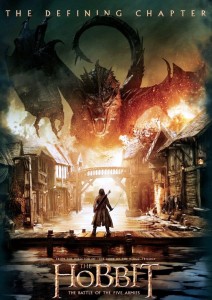 I’ve written tens of thousands of words on the Hobbit trilogy. It truly appears that there is nothing left for me to say about it. But it’s not over. Not yet.
I’ve written tens of thousands of words on the Hobbit trilogy. It truly appears that there is nothing left for me to say about it. But it’s not over. Not yet.

